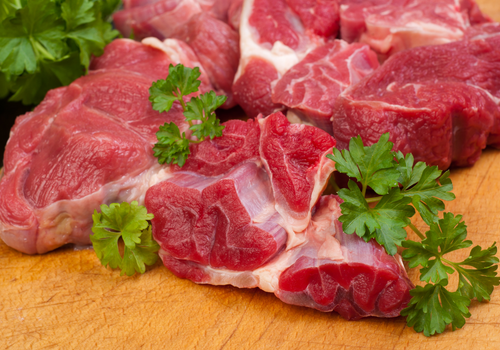Are red meats like beef really as unhealthy and chicken as healthy as the media makes us believe? It’s a difficult question to answer and a tricky comparison; a new study has shown that chicken and beef contain equal amounts of cholesterol. Chicken, like most white meat, is quite healthy but some chicken cuts have higher saturated fats than beef and some beef cuts have lower cholesterol.
With decades of experience in chicken and beef production processes, talking to animal butchers, working as a chef, and going to culinary school, I’ve garnered enough knowledge about this key element in gastronomy.
So, today, in this chicken vs. beef comparison, we’ll look at the healthiness of the most eaten meats (chicken and beef), their nutritional value, breeding problems, and more.

Chicken consumption has been on the rise in recent years. Does that mean people are beginning to realize how harmful to health beef and other red meats may be?
Without its outer skin, this popular poultry is lower in saturated fat than most cuts of red meat. Its white flesh has less saturated fat than its brown flesh, but both provide more than a dozen essential vitamins and minerals.
Next, I’ll be analyzing some of the primary benefits of chicken.
P.S. I’m talking about organically-raised chicken only.
Chicken is great for the health in any dish – unless you’re the chicken, of course! Jokes aside, the benefits of poultry are plentiful.
In a lean breast cut, it’s low in saturated fat, has low calories and high proteins, making it great for weight management. Not to mention, when raised ethically and organically, this bird is packed with essential nutrients.
Below are the key benefits of healthy chicken and some of its nutritional information:

Chicken meat is great if you’re looking for a great source of lean protein that is low in saturated fat. The protein chicken provides is good for muscle development and growth. It also ensures a healthy weight and aids in weight loss.
Chicken is high in tryptophan, a beneficial amino acid. Eating this poultry meat will help those depressed to increase serotonin levels, improve their mood, relieve stress, and lull them to sleep.
Eating chicken can help build bone density and fight bone loss because of the high protein content of chicken. This will be helpful for older adults who may be worried about arthritis and osteoporosis.
Poultry like chicken and turkey without the skin are good for the heart. Taking chicken breast can help suppress and inhibit levels of homocysteine, an amino acid that causes cardiovascular diseases. Breast meat also has high levels of polyunsaturated fatty acids.
Chicken is high in Vitamin B6 which promotes metabolic cell reactions. Thus, the meat from this bird will keep the blood vessels in healthy conditions, keep energy levels high, and boost metabolism that burns calories, for a healthy lifestyle.
According to the results of a Consumer Report Analysis, 97 percent of retail chicken breasts are CONTAMINATED with dangerous bacteria that can make you fall sick.
Also, I’ve heard many people say they started consuming more chicken meat because of its “lower cholesterol”. Don’t be surprised; chicken contains the SAME cholesterol levels as beef or other red meat. So, the problem might not be the beef but the cuts you consume and your overconsumption.
I’m not here to scare chickentarians. However, the FDA has admitted that your favorite meat is stuffed with a lot of arsenic. This is a highly toxic substance dubbed four times as poisonous as mercury. Affected birds are those treated with 3-Nitro or birds treated with Roxarsone drugs that improve the birds’ muscles and make their meat pinker. After all, these are “meat qualities” you watch out for.
The good news, however, is that the FDA ordered that these drugs be withdrawn from the chicken feed market. The bad news is withdrawal is an ongoing process.
Beef contains 26 grams of protein per 100-gram beef steak. I advise that you always choose unprocessed meats, which are richer in protein. Indeed, minced steak (5 percent fat) has 26.3 g of protein per 100 grams; merguez (composed of beef and mutton) contains only 19.8 g/100 g; beef meatballs contain just 15.2 g/100 g.
As for cooking, the preparation methods that best preserves the proteins in beef are broiled ground beef, braised beef and beef bourguignon. Have you tried any of them?

Beef is one of the most important suppliers of the mineral iron, heme iron, that the body can use particularly well. Beef also contains vitamin B12, found almost exclusively in animal-sourced foods. Here are the health benefits of beef meat in full:
Free-range and pasture-raised beef, preferably organic, is rich in Omega 3. Because of the grass feed, there are more anti-inflammatory omega-3 fatty acids and less pro-inflammatory omega-6 fatty acids in this meat.
Beef is one of the good suppliers of vitamins from the B group, especially niacin. Among other things, it is essential for energy metabolism and the formation and breakdown of carbohydrates, amino acids, and fatty acids.
Many athletes and fitness fans prefer beef. This is mainly because beef offers large amounts of optimally usable protein: These proteins help build and maintain stronger muscles faster than those provided by chicken meat. Beef contains significantly higher creatine which will help produce lean muscles much more quickly than chicken meat.
Beef meat is rich in l-carnitine, a substance used by the body to turn body fat into energy. A 3oz serving of beef meat contains about 80 mg of l-carnitine. Chicken meat does not have much of it. L-carnitine transports sugar to the muscles and contributes to the proper metabolism of fats.
Beef meat is rich in glutathione. This is the king of antioxidants. It helps fight oxidative stress while maintaining good muscles and improving our performance.
According to several studies, heavy consumption of beef (especially processed meats) and other red meat increases the risk of colon cancer by 24 percent and those of the esophagus, liver, pancreas, or lung by 20 to 60 percent. This is caused by nitrate and nitrite compounds in these animals.
In terms of colon cancer risk, chicken remains the healthier choice. However, eating large amounts of red meat increases your risk of developing it. This connection has not been found with white meats. However, people whose cholesterol levels are high should not just steer clear of red meat but also eat turkey steaks and chicken cutlets in moderation or just eliminate meat consumption.
However, a study published in BMC Medicine associated eating meat five times or less per week with lower overall cancer risk.
Today, beef and chicken have been making plenty of negative headlines. For example, high beef consumption is said to promote cancer, gout, and cardiovascular diseases. And we keep reading about new meat scandals every day.
Most people assume that white meat is a better option than red meat. However, to a great extent, it depends on your chosen cut. Chicken meat is not always better than red meat. There are cuts with more saturated fat or cholesterol than a beef fillet.
A beef fillet has about 8 grams of fat per 100 grams, although there are lean cuts whose lipid content can be reduced to 5 percent.
While chicken breast has a fat value of approximately 6-7 percent and therefore can be a leaner option than a beef fillet, other cuts far exceed the latter in terms of lipid value.
This is the case of legs and thighs with around 12 grams of fat per 100 grams or the chicken wing that is the fattest cut with 16 percent of fat.
Thus, beef tenderloin or a lean cut of beef may be a better option than chicken legs or wings if you are looking for low-fat proteins for dieting.
The best chicken cut is the breast. It has a high protein chicken content and low saturated fat for the body, similar to turkey breast.
Related Reading

Researchers from the Children’s Hospital Oakland Research Institute have examined how eating red meat affects cholesterol levels compared to white meat like chicken or a meat-free diet.
The researchers divided their subjects into a total of six groups. The participants received a diet that either contained a lot of red meat, a lot of white meat, or only plant-based protein suppliers. There was one group whose meals contained a lot of saturated fatty acids (a total of 51 people) and a group that only consumed small amounts of them (a total of 62 people).
However, the result of the research showed that the negative effect of red and white meat (i.e. beef and chicken) on cholesterol levels was the same inasmuch as the meals contained the same amounts of saturated fat.
Both beef and chicken have their benefits and downsides. It all depends on the cuts of the animal we’re talking about and how much your consumption is.
If you ask me as a meat lover, I suggest that you stick to beef. You’ll realize why if you’ve been following my recipes. A favorite of BBQ fans, beef is the easiest to grill, and there are up to eight cuts of beef. With chicken, you have just four different cuts.
Consuming beef once a week is more than enough to cover our needs. Other proteins will be provided by eggs, nuts, goat, sheep, cheese, fish, and occasional chicken consumption.
Note that you will only be able to obtain all the benefits of beef if you absolutely consume grass-fed beef. It is better not to consume it if you are unsure of its origin. I have a butcher near my house who traces his animals to the slaughterhouse, where they are not mistreated.
There are also websites of ethical breeders who only raise their animals on grass, one of which I use. You can order some and put them in your freezer. Beef can last up to 4 months in the freezer.
Chicken meat is high in protein, has a lot of vitamins, and minerals, while grass-raised beef contains omega-3s that fight inflammation. Their heme iron is much better absorbed. In the end, it doesn’t really matter what you choose. Both beef and chicken meats are quite healthy for the body. The risks in high cholesterol are quite low when not over-consumed.
Eating healthy has become more complicated. So, let’s eat less. Intensive farming would become obsolete by eating less meat, and our cows could return to the meadow from which they should never have left.
Before, it was famines that forced us to eat less. Today, it’s the toxicity of animal feeds and drugs to gain more profit and meet market demands. Long live progress! Just kidding.